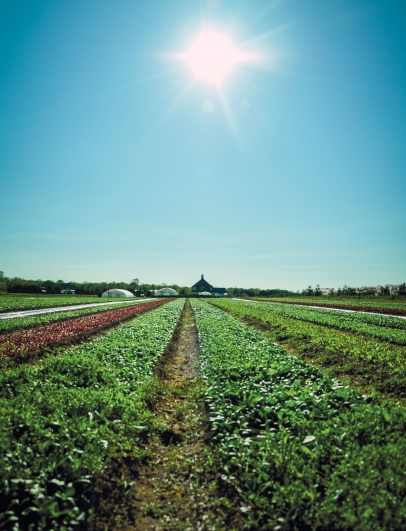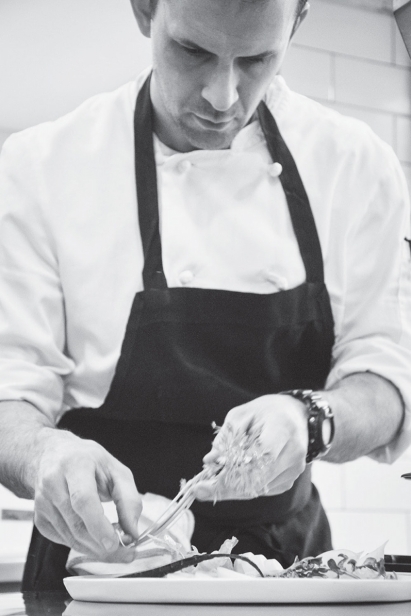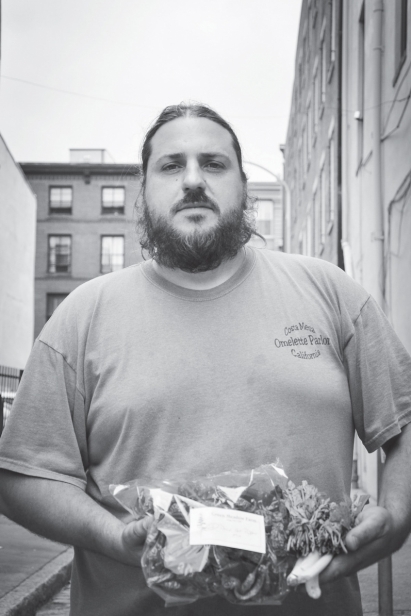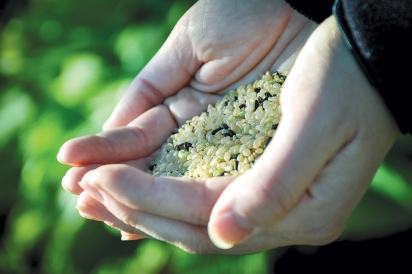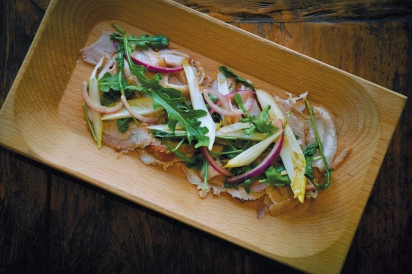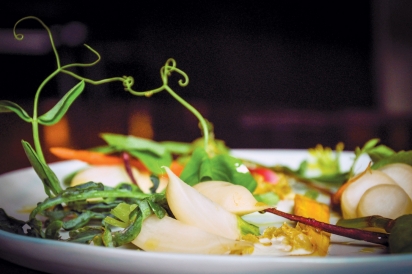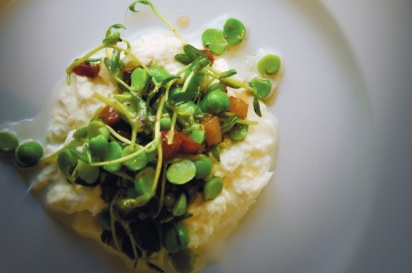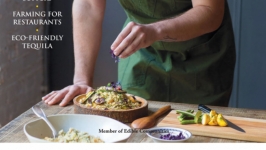Farming for Chefs
When the people who cook your food team up with those who grow it, delicious things can happen
Much has been written about the star chefs whose creative cooking has made Philadelphia one of the best restaurant cities in America. Less has been said about the farmers growing the standout ingredients that make many of their menu items possible. The fact is that chefs and farmers frequently work closely together, collaborating on what to plant and when to harvest. Often the most desirable crops for chefs are the trickiest to grow, requiring serious TLC on the part of an attentive and committed farmer. The challenge pays off, though, in terms of both the premium prices restaurants can pay for these ingredients and the satisfaction that comes from cultivating items that once seemed impossible for the region. The relationships between these chef-farmer duos are an integral part of what makes food in Philly so great right now. Here’s an inside look at how they work.
Green Meadow Farm
When Glenn and Karen Brendle started Green Meadow Farm in 1981, there was no farm-totable movement in Philadelphia. Since then, the Brendle family has built their business on supplying the city’s top restaurants. In the early days, though, chefs were slow to catch on that the best products could be grown so close to home.
“It took years of building trust with chefs,” says Ian Brendle, Karen and Glenn’s son and business partner. Glenn was ahead of his time, growing rare heirloom varieties that stood out in flavor and quality. Varieties like the richly flavored Mortgage Lifter tomato and the tiny, fragrant Charentais melon were uncommon back then. Soon, however, the Brendles had a reputation among ambitious chefs for their standout produce.
Today, Green Meadow offers more than 80 different fruits, vegetables, herbs and legumes to more than 100 restaurants in and around the city. Its usual offerings are pretty special: They include Hosenshank pears, a local cider variety from the farm’s 250-year-old tree; Tromboncino summer squash, with a flavor similar to sweet corn; and fresh Orca shelling beans, whose skin is patterned in black-and-white splotches.
Even more remarkable are the banana leaves, which chefs often use as a wrapping to steam or grill meat or fish. For a short time each summer, Green Meadows even offers local bananas. A biofuel-powered greenhouse allows the farm to defy nature by growing tropical fruit in southeastern Pennsylvania in a sustainable way.
“There is a huge difference in both flavor and texture in a tree-ripened banana,” says Brendle. The texture is creamier and the taste is more pronounced than in store-bought bananas, which are picked green, shipped long distances, and ripened in ethylene gas. When the fruit ripens on the tree, usually early summer, the farmers have to act fast:. The skins split quickly, and ants will invade to get to the sweet flesh. These bananas have made their way onto plates at the likes of farm-to-table restaurants such as Russet, where pastry chef Kristin Wood turns this anomaly—a Pennsylvania-grown banana—into a truly local dessert. With last summer’s bananas, Wood roasts the fruits with brown sugar and rum, then adds them to a vanilla-caramel base to make an ice cream that is served with hickory-nut cookies (naturally, the cream and the nuts are also sourced through Green Meadow). “We have been using Green Meadow products for over nine years and love working with them,” says Wood. “At Russet, we buy as many ingredients as possible from people we know personally, because we know that’s the best way to get the highest quality.”
The rapport the Brendles have developed with chefs over the years influences what they grow. Chef Joe Cicala of Le Virtu in East Passyunk has worked with the Brendles since 2010. What the team at Le Virtu can’t bring in directly from Abruzzo, the region in Italy that inspired the restaurant, Cicala buys from local farms like Green Meadow.
Cicala and the Brendles have collaborated to bring Abruzzo staples to Lancaster County. Cicala prizes a particular variety of red garlic he brought back from a trip for its pungent, fresh taste, but he and the Brendles estimate that it will take them six to eight years to establish a commercial crop at Green Meadow. Although Cicala won’t get to cook with a local version of the garlic for several more years, the wait is worth it—for chef and farmer alike.
Peppers transition from the Mediterranean to the mid-Atlantic a little more easily; Ian Brendle grows more than 30 different varieties that go into a hot-pepper mix he dries in his barn. Hot peppers, along with garlic and olive oil, are the backbone of Abruzzi cuisine, and a little of the mix ends up in almost every dish. Cicala’s pasta dishes are served with peperoni cruschi, literally “crispy pepper,” on the side—along with scissors diners can use to trim slices of this dried and fried pepper onto their pasta.
The relationship between chef and farmer is one of give and take; neither can exist or excel without the support of the other. Chefs are willing to pay a steep price for specialty produce items grown at a high level of quality, which helps farmers like the Brendles keep their operations profitable.
“The only way that we are able to grow these different types of things is because Philadelphia is such a wonderfully chef-driven city,” says Ian Brendle. Otherwise, he adds, “we wouldn’t be able to do it.”
Blue Moon Acres
If you’ve ever been served a plate garnished with pretty, Lilliputian greens, they may well have been grown at Blue Moon Acres Farm in Buckingham, Pennsylvania. Jim and Kathy Lyons started growing these chef-friendly microgreens there in 1993 with an eye toward wholesaling the tiny sprouts to fine-dining restaurants. At the time, it was a novel idea for area farms.
Since then, the Lyons family has built a small empire around their organic microgreens, baby salad greens and vegetables, with on-farm stores in Buckingham and in Pennington, New Jersey, and a retail presence at many other venues, such the Doylestown Food Co-op. Their wholesale accounts stretch from New York to Philly. Blue Moon was one of the first local farms to grow tropical crops like turmeric and Hawaiian ginger, which chefs prize for its gentle flavor and tender, tuberous flesh.
In 2013, with their reputation as innovators of organic agriculture firmly intact, the Lyons family, along with Pennington farm manager Scott Morgan, did something that, as far as they knew, had never been done before: They grew rice in New Jersey. “There’s not one chef I didn’t get a surprised reaction from when I told them that we could grow rice,” says Ashley Lyons Putman, Jim and Kathy’s daughter and Blue Moon’s sales manager. “They were staring at us in disbelief. It was really something that chefs wanted to get their hands on.”
The 2014 crop went on sale in December and was sold out by March. What’s even more remarkable about Blue Moon’s rice is that it’s not grown the usual way—in a paddy flooded with several inches of water—but in a dry field, just like other grain. The farm offers short, medium, and long-grain varieties in brown and white—suitable for sushi, risotto, and pilaf, respectively—as well as a sticky, inky-colored black variety that will stain white rice lavender when the two are cooked together.
While the rice was initially in short supply— New York City’s Gramercy Tavern snapped up most of the crop that first year—Blue Moon has started retailing one-pound bags at its farm stores. Chefs across the region have had a chance to wrap their heads around the ingredient and are now incorporating it into their menus.
Last winter, chef Eli Collins of Pub & Kitchen in Rittenhouse Square experimented with a wintry stew. In his dish, the Blue Moon rice was no afterthought or blank canvas: It had a starring role alongside the meatballs, vegetables and savory pork broth. “The rice’s flavor is almost peanutty—it has an amazing nuttiness and earthiness to it,” says Collins. “I’ve never cooked rice like that before.”
“There’s a great synergy in working with chefs,” says Ashley Lyons Putman. “We realized this early on, growing microgreens. They’ll come to you with something that you’ve never even heard of before. It’s fun to do that research, try something, and send it to the chef [for] feedback [and hear], ‘This is exactly what I was looking for, and I had so much trouble finding it.’”
But rice farming is not without headaches. While Blue Moon has been pleased with its yields so far, the product is expensive to grow and process, retailing at $10 per pound. The grains are stored, then cleaned and milled to order on specialized equipment, which results in two byproducts: rice bran, also called nuka (the brown part of brown rice), and broken rice. At the end of the season, the farm offers the broken rice to chefs, who can use it to make congee or rice grits, a classic Southern dish.
Finding a use for the bran, however, requires pickling skills that might be unknown to even the most avid fermenter. Nukazuke are a type of Japanese lacto-fermented pickle that’s made by roasting the nuka, then adding salt, water and optional flavoring agents like pepper, ginger or kombu. This forms the nukadoko, or pickling bed, in which vegetables are buried to ferment. The mixture must be aerated and turned by hand at least once a day. “Rather than tasting the vegetables, you taste the nuka” to check its progress, says John Patterson, chef de cuisine at Fork in Old City. “If it’s bland, you can add more salt. If it’s too salty, you can add more nuka to even it out.”
At Fork, devotion to the local goes beyond the kitchen: The site hosts a weekly mini–farmers’ market featuring Bucks County’s Plowshare Farms. Patterson works with Plowshare to rescue any leftover veggies, which are pickled to a pungent, bright flavor and crisp texture in the nukadoko. This symbiosis shows the cycle of Fork’s relationship with its purveyors through the pickles, which make their way to a crudité platter that’s served during dinner, perhaps alongside crisps made from Blue Moon rice.
“The nuka pickle is a way that we can present some of those ingredients and have it [continue] to evolve,” Patterson says. “It’s utilizing the byproduct of growing rice and processing rice and figuring out a way that we can bring flavor and technique,” which contributes to an ongoing conversation about why the rice crop is important in this region, he adds
Lancaster Farm Fresh
“In the beginning, there wasn’t necessarily that personal relationship with the chefs who bought from us,” says Casey Spacht, general manager for Lancaster Farm Fresh cooperative in Leola, Pennsylvania. The co-op [named a “2016 Local Hero” in Edible Philly’s Spring issue] has been supplying restaurants with produce for a decade. It counts many Amish farmers among its members. They often eschew the Internet and limit their use of phone lines and fax machines; some rely on horses and buggies rather than cars and trucks to get around. “There wasn’t as much dialogue about ‘This works, this doesn’t,’” says Spacht. “‘You want beets? Here’s beets,’ and that’s as far as it went.”
Spacht’s mission is to keep this cooperative of Amish farmers doing what they do best—growing food. So instead of the farmers putting their heads together with cooks, Spacht does it on their behalf. He regularly sits down with chefs to get specific about what will work best on high-profile menus. “There’s 20 varieties of red beets,” says Spacht. “‘Which is the best for you? What size do you want? What kind do you want?’ I’d bring in catalogues and sit them down.” Chefs would respond enthusiastically: “‘Ooh, Bull’s Blood beets work best for us because the tops are red.’ Stuff like that.” With this kind of proactive outreach, Spacht is able to get the information his farmers needed to grow top-quality organic produce to their customers’ specifications—and build long-lasting wholesale relationships across a service area that now stretches from Washington, D.C., to New York.
Outsiders often assume that Amish farmers exclusively grow heirlooms or seeds that have been saved through generations of farming families. Of course, many do grow some of those things, but they are just as likely to plant new crops. Spacht and his team pore over seed catalogues each winter to spot exciting new seed varieties, then work closely with chefs to test and produce crops they’re excited to buy and show off on their menus.
Tangerine Lace is a great example. Last year, Sean Rembold, chef at Reynard at Brooklyn’s Wythe Hotel, cooked in a chef competition in Nashville. At the event, he discovered Tangerine Lace, a petite leaf with a fernlike shape and a pronounced citrus flavor. Afterward, Rembold told Spacht he’d buy as much as the cooperative could grow. Now this tiny sprig with lemony bite is a huge seller for Lancaster Farm Fresh. “I just visited eight restaurants in New York City, and at each of those places I went to, they were like, ‘Wow, that Tangerine Lace was amazing,’” says Spacht.
Tangerine Lace is grown from the seeds of the Lemon Gem variety of marigold, which produces flat, dime-sized, edible yellow flowers with a citrusy flavor. Its greenery, while fragrant, isn’t appealing to eat at full size. When the leaves are 10 to 20 days old, though, they’re still tender and packed with that zingy flavor.
Patterson, who seeks to incorporate citrus flavors where he can find them for Fork’s highly Southeast Pennsylvania-centric tasting menu, is a big fan of Tangerine Lace. “We were going through three pounds a week.” Fork’s kitchen incorporated the frilly, frond-like leaves into a smoked shrimp carpaccio dish last year. The green has even made its way into the bar menu, in a cocktail along with gin, Lillet, citrus and dandelion.
It’s true that much of what Lancaster Farm Fresh farmers cultivate is inspired by their chef customers. But the inspiration flows both ways. The cooperative inspires the chefs, too. According to Spacht, the farmers’ taking the time to come to the city and sit down with a chef to geek out over seed catalogues really opens up what will make it onto menus the next season.
Chefs “are working with what they have, and it’s so immediate and fresh, and that’s how they’re rolling. But they need us to come to them and say, ‘This is what the norm is, but we can do all of this, too,’” says Spacht.
SOURCING THESE SPECIALTIES FOR THE HOME KITCHEN
While there’s a reason these hard-to-find items aren’t widely available, between the Internet, specialty grocers and specialty supermarkets, you can get your hands on them. Here’s how.
Peperoni cruschi. This name refers not to a variety of pepper but to a preparation—and it’s cheaper to make your own than to seek it ready-made from Italy. Talk to your favorite farmer to make sure you’re purchasing good varieties for drying. Seek a sweet-spicy pepper that’s not too hot. Peperoni di Senise would be ultra-authentic, but pasilla or guajillo chiles can substitute. Remove the stems and seeds of the dried peppers, then fry lightly in olive oil and toss with sea salt.
Cruschi peppers, or pepperoni cruschi, zingermans.com, $22 for 25 grams; amazon.com, $5.24 for .9 ounces.
Banana leaves. Green Meadow’s supply of banana products is sold only to chefs, but you can find nonlocal banana leaves at most Asian grocery stores; H-Mart in Upper Darby and Hung Vuong Supermarket at 11th and Washington both carry them frozen.
For bulk orders requiring fresh leaves, look to John Vena, Inc., at the Philadelphia Wholesale Produce Market or the online store of Melissa’s Produce.
Fresh banana leaves, melissasproduce.com, 6–7 pound pack for $28.99 plus two-day shipping; or John Vena, Inc. (call for pricing and availability); frozen banana leaves, H-Mart, 1 pound for $1.99.
Local rice. Find a wide array of microgreens and certified organic rice while supply lasts at Blue Moon Acres’ farm stores on site at their Buckingham, Pennsylvania, and Pennington, New Jersey, operations. Look for Blue Moon’s microgreen blends year-round and fresh young ginger in season (late summer/early fall) at the Fair Food Farmstand in Reading Terminal Market.
Organic rice, $10–14 per pound. Available at Blue Moon Acres Farm stores: Wednesday–Friday 9am to 6pm and Saturday and Sunday 9am to 5pm, 11 Willow Creek Dr., Pennington, NJ; Tuesdays and Fridays 10 am to 4pm, 2287 Durham Rd., Buckingham, PA. Nonlocal source: Organic nuka, $5.75 for 1.5 pounds, rhapsodynaturalfoods.com.
Tangerine Lace. While Tangerine Lace hasn’t quite gone mainstream enough to show up in grocery stores in Philly, online retailers can meet your needs, and Lancaster Farm Fresh CSA members sometimes get this item as part of their shares. The Philadelphia Wholesale Produce Market is another potential source: John Vena can special-order clamshells of Tangerine Lace micros. Or save a few bucks and have fun getting your hands dirty: Grow your own with Lemon Gem Marigold seeds. Harvest micros for garnish at around 10 days, when the shoots are an inch long, or wait two to three weeks for the “petite” stage (two to four inches in length) to add to salads. Once the plants grow to full size, the aromatic leaves are no longer considered edible, but the flowers are. Gourmetsweetbotanicals.com, $7.50 for 2 ounces of microgreens; johnnysseeds.com, $3.95 per packet.
Get a taste of these special local items during their growing seasons at the following restaurants:
FORK
306 Market St.
215.625.9425
PUB & KITCHEN
1946 Market St.
215.545.0350
RUSSET
1521 Spruce St.
215.546.1521
LE VIRTÙ
1927 E. Passyunk Ave.
215.271.5626


